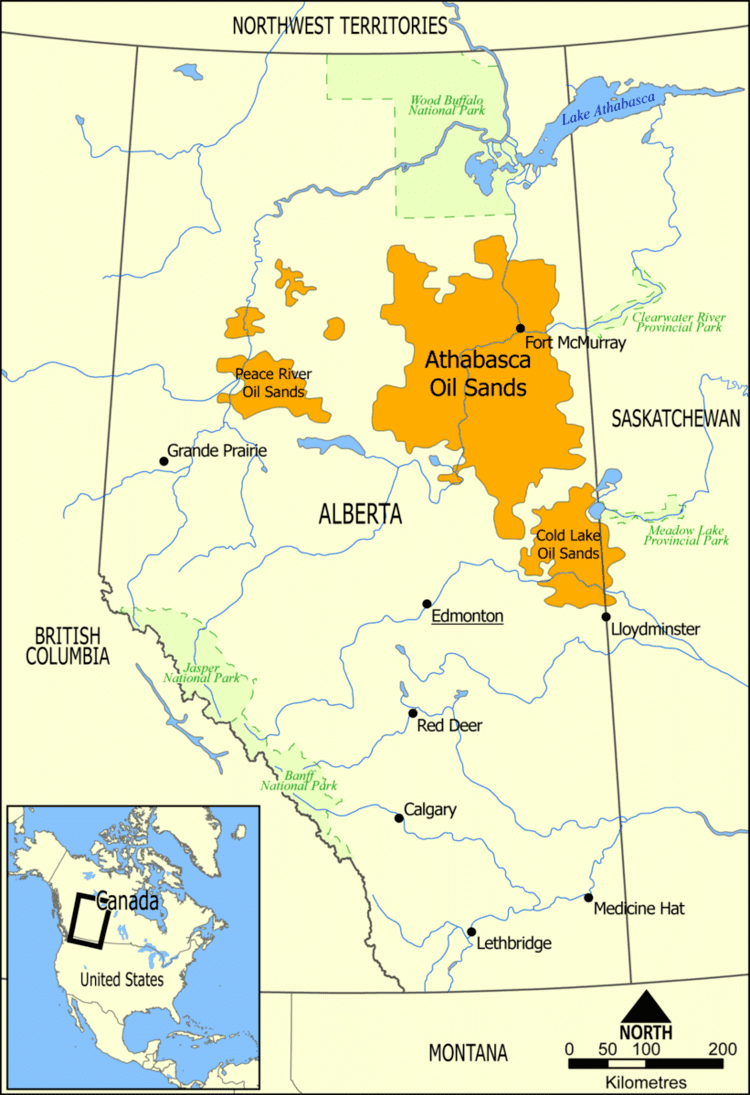 | ||
Location Western Canadian Sedimentary Basin Offshore/onshore Onshore, unconventional Hours Open today · Open 24 hoursSaturdayOpen 24 hoursSundayOpen 24 hoursMondayOpen 24 hoursTuesdayOpen 24 hoursWednesdayOpen 24 hoursThursdayOpen 24 hoursFridayOpen 24 hours Similar Civeo ‑ Wapasu Creek Lo, Suncor Firebag Village, Shell Albian Village, Husky Energy ‑ Sunrise E, Barge Landing Lodge | ||
Imperial oil first production from kearl oil sands project
The Kearl Oil Sands Project is an oil sands mine in the Athabasca Oil Sands region at the Kearl Lake area, about 70 kilometres (43 mi) north of Fort McMurray in Alberta, Canada. The project is being developed in three phases with the first phase completed mid-2013.
Contents
- Imperial oil first production from kearl oil sands project
- Kearl oil sands project
- Project description
- Ownership
- Regulatory agencies
- Criticism
- Kearl Module Transportation Project
- References
Kearl oil sands project
Project description
The development is an open-pit mining operation, which will be developed in three stages. At the first stage it will produce approximately 110,000-barrel-per-day (17,000 m3/d), with later expansions to more than 300,000 barrels per day (48,000 m3/d). It uses a froth treatment technology producing blended bitumen which will be transported to the Edmonton area by Enbridge's pipeline system. Diluent would be provided from Edmonton through the Inter Pipeline owned 454 kilometres (282 mi) long 12 inches (300 mm) diameter pipeline supplying the Athabasca Oil Sands Project. The Kearl oil sands facilities would be connected with this pipeline by a 50 kilometres (31 mi) long new branch.
At the first stage the development would involve capital spending of about C$8 billion, with the final estimate being highly dependent on the final upgrading option selected. An engineering, procurement, and construction management contract for the first phase was awarded to AMEC while Fluor Corp. is responsible for the development of infrastructure and facilities.
When ExxonMobil proposed the Kearl project in 1997, estimated recoverable bitumen resources were 1.2 to 1.4 billion barrels (220×10^6 m3). Later revisions place the actual established reserves at over 5.5 billion barrels (870×10^6 m3) (Energy Resources Conservation Board 2010).
The development is located on the following oil-sands leases:
Ownership
Imperial Oil Resources owns 70% of the project and ExxonMobil Canada Ltd. owns 30%.
Regulatory agencies
Criticism
Sierra Legal launched legal action in Canadian federal courts to overturn the Department of Fisheries and Oceans regulatory approval (Ecojustice Canada 2007-03-30). They said that the joint federal-Alberta regulatory panel "failed to do its job" when it gave conditional approval to the $7 billion Kearl open-pit mine. They argued that a full environmental review must take place before the federal government decides whether the project should proceed.
After a joint federal-provincial panel reviewed and upheld the original decision, a key water permit was reinstated, pending approval from Imperial's board of directors. Delayed again in response to the 2008 fall in oil prices, Imperial Oil decided in May 2009 to proceed with the project, taking advantage of the soft local economy to cut costs.
The Alberta Federation of Labour criticised the plan's lack of an upgrader, as "that's where the real jobs are", referring to the intent to pipe diluted bitumen south for upgrading.
Residents of Idaho and Montana have criticized the plan to transport "Oversized Loads" of prefabricated parts of oil extraction "modules" over U.S. Route 12 along the narrow curving byways of the Clearwater and Lochsa River of the National Wild and Scenic Rivers System, over Lolo Pass, through Missoula, Montana, and into Alberta.
Kearl Module Transportation Project
Mammoet, a developer and user of Self Propelled Modular Transporters is using SPMTs (14 Line 16' Wide Goldhofer Hydraulic Platform Trailer) in conjunction with Class 8 Tractors to transport modules (deemed "oversized loads") of oil extraction parts on the "Kearl Module Transportation Project" from the port of Lewiston, Idaho, through the U.S. states of Idaho and Montana to the Kearl Oil Sands Project.
